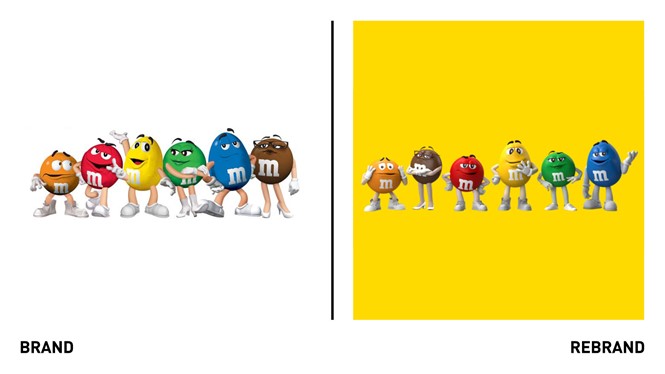M&M’S rebrands its characters in global commitment to greater inclusivity

Mars Incorporated-owned candy brand, M&M’S, has announced a new global commitment to greater inclusivity, aiming to build a world where everyone feels they belong.
As part of the new brand strategy, which aims to reflect a more progressive and modern world, M&M’S is refreshing its iconic characters, the most recognisable assets of the brand. The mascots will have different shapes and sizes, and more nuanced personalities to underscore the importance of self-expression.
These changes include replacing the green M&M’S high-heeled white boots with sneakers, and the brown M&M’S stilettos with lower heels. Green also embraces the “hypewoman” character, throwing “shine” and not “shade” on other women. In a Q&A on the M&M’S website, the candy says she is happy to take on the role of the supportive friend when other women succeed, because “we all win when we see more women in leading roles.”
The updated tone of voice will seek to be more inclusive, welcoming and unifying.
“From new product innovations to brand campaigns, our evolved characters and our experiential retail stores, we'll incorporate colourful visuals, inclusive messaging and our purpose into all we do to prove that all together, we're more fun,” said Jane Hwang, global marketing VP at Mars Wrigley, in a press release.
The refreshed look also puts greater emphasis on the ampersand, a distinctive element within the M&M’S logo that connects the two M’s, to showcase how the brand aims to bring people together. M&M’S promises to use the power of fun to increase the sense of belonging for 10 million people around the world by 2025.
"M&M'S has long been committed to creating colourful fun for all, and this purpose serves as a more concrete commitment to what we've always believed as a brand: that everyone has the right to enjoy moments of happiness, and fun is the most powerful way to help people feel that they belong," said Cathryn Sleight, chief growth officer at Mars Wrigley, in a press release.
However, not everyone is persuaded by the authenticity of the rebrand and new global strategy. Tim Jones, strategy director at global brand agency, venturethree, sees the character update as a mere executional decision and visual asset update.
“This isn’t true purpose. Action defines character and I can’t see any meaningful corporate action coming out of this except the weird decision to tie Orange’s shoelaces. Maybe the M&M brand team will convince the Mars Wrigley board to sacrifice profit to support mental health amongst young men. Maybe they will give staff 20 hours volunteering a year to teach and offer hundreds of work placements to inspire young girls to be a boss. This behaviour might suggest they have found purpose but shaving a few inches off the heels of a cartoon sweet isn’t convincing me they have,” he says.
Simon Manchipp, founder and executive strategic creative director at design agency, SomeOne, agrees. He describes the rebrand as a ‘cheerful update’ rather than a radical change.
“It’s bright. It’s cheerful. It’s American. And it always was. While the design fraternity tie themselves in knots over the strength of a (very nice) set of serifs, I'd question if the general M&M consuming public will notice much of a strategic change. However, it’s not impossible. Brands have managed to make this kind of leap before. Time will tell if M&Ms can genuinely demonstrate global unity,” Manchipp says.
The rebrand has also sparked controversy online. Ken Klippenstein, investigative reporter at news organisation, The Intercept, tweeted “Sorry you don’t get a say in the distribution of resources, could we interest you in a lively debate about the gender of M&Ms instead?”. This alludes to how the rebrand is a front to cover other, more serious, issues, such as where Mars sources its raw materials from or who works in its supply chains.
Similarly, journalist and historian, David M. Perry, tweeted an article by The Independent that looked at how seven major cocoa companies, including Mars, are accused of using child labour in their supply chains.

Similarly, journalist and historian, David M. Perry, tweeted an article by The Independent that looked at how seven major cocoa companies, including Mars, are accused of using child labour in their supply chains.

For Daniel Golden, managing director of NYC-based B2B branding agency, DeSantis Breindel, it comes as no surprise that people have taken the debate to social media.
“The ‘rebrand’ feels more like a campaign-like stunt than a true rebrand that has defined a new core operating philosophy for the organization. It would be a different story if Mars and M&Ms started to effect change from the inside out which then ultimately manifested in a change of its advertising approach down the line. What they [Mars] have done is just change their mascots, which feels hollow. I think consumers today can easily sniff out things like that and their suspicions quickly become validated and amplified in the echo chamber of social media,” he says.
Ultimately, Golden believe that being a globally recognised and loved brand doesn’t give M&M’S permission to take on macro societal issues. “We’re talking about candy here. Sometimes it’s good enough to just be delicious,” he says.
However, this isn’t the first time Mars Incorporated has taken on ‘macro societal issues,’ rebranding its products in a bid for greater inclusion and equity. In 2020, following the Black Lives Matter protests, Mars’ rice brand, Uncle Ben, renamed to Ben’s Original. This followed accusations of racial stereotypes, in which black people in southern Confederate States were referred to as ‘aunt’ or ‘uncle’ rather than Ms. or Mr.
The M&M’S new global commitment is part of a wider set of actions taken across Mars Incorporated brands to embrace and reflect a more inclusive society. This includes cat food brand, SHEBA’s coral restoration programme, or Mars Bar’s pledge to become carbon neutral by 2023 in UK, Ireland and Canada.












